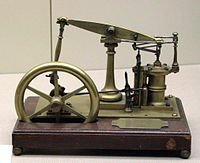
Photo from wikipedia
Abstract Steam condensation consisting of noncondensable gas has been broadly investigated on external surfaces of various single tube and plates. Previous numerical analyses revealed that the high concentration air layer… Click to show full abstract
Abstract Steam condensation consisting of noncondensable gas has been broadly investigated on external surfaces of various single tube and plates. Previous numerical analyses revealed that the high concentration air layer (HCAL) is the main thermal resistance for condensation. Comparing with the single tube/plate, condensation for bundle can be more complex. The HCAL near the adjacent tube surfaces may interfere and then influencing flow and heat transfer characteristics in the bundle. To evaluate the bundle effect, this study conducted experiments based on a 3 × 3 tube bundle at a wider pressure range (0.15–1.6 MPa). The results indicate that the bundle effect can be divided into two sub-effects: the enhancement effect and the inhibition effect, and the enhancement effect can make the average heat transfer performance of the bundle better than that of the single tube. The parameter thresholds for the two sub-effects were determined according to the broaden parameter scope. Generally, at small subcooling and low pressures, the inhibition effect dominants, and the bundle condensation heat transfer coefficient (CHTC) can be 22% less than that of the single tube; at large subcooling and high pressures, the enhancement effect dominants, and the bundle CHTC can be 71% greater.
Journal Title: Progress in Nuclear Energy
Year Published: 2021
Link to full text (if available)
Share on Social Media: Sign Up to like & get
recommendations!